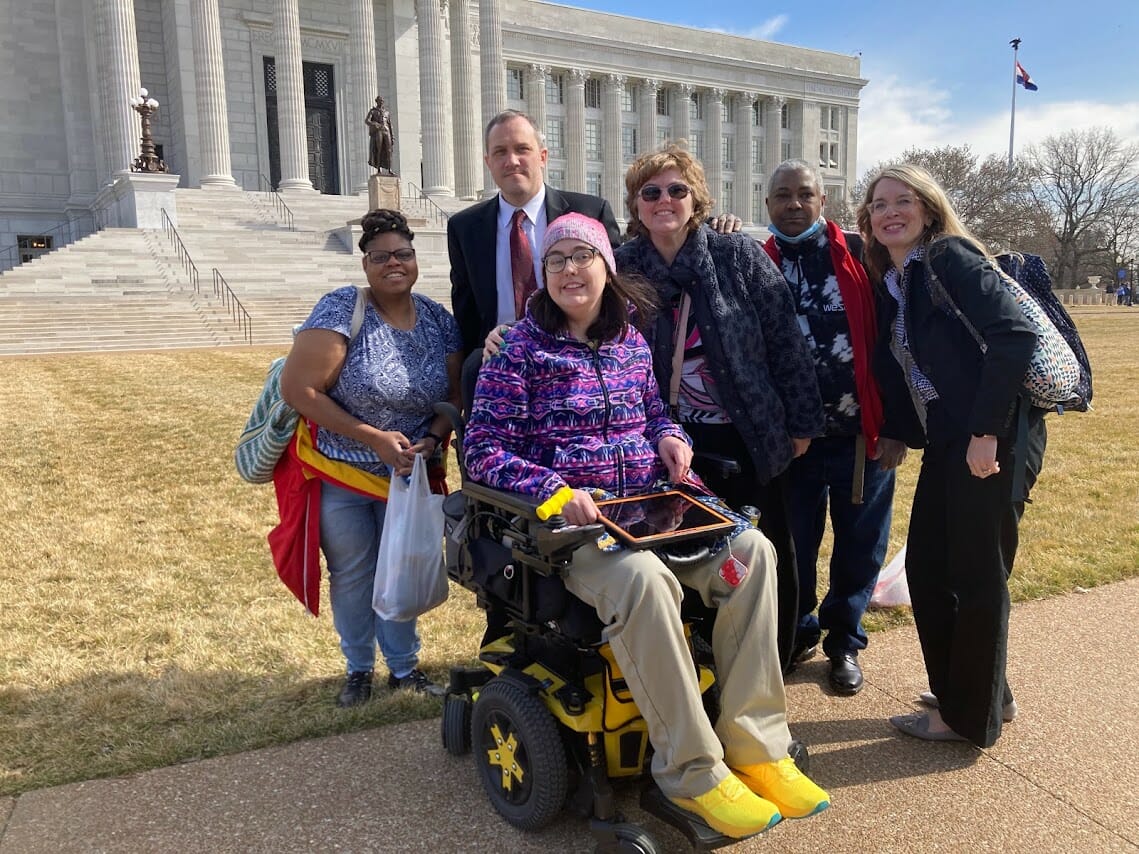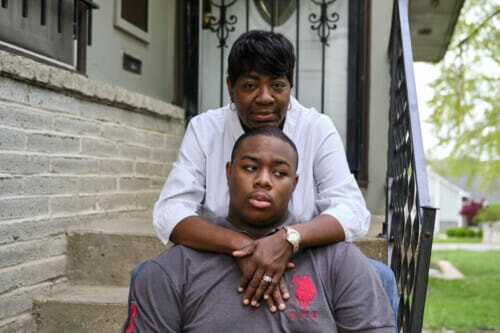Young Adults with Disabilities Want Independence. Guardianship Is a Hurdle. In the Kansas City area, self-advocates and public guardians see a need for a more tailored approach to support adults with disabilities
 Nicole Noblet (at center in purple) with Missouri's People First Chapter at Disability Rights Legislative Day at the Capitol. (Contributed)
Nicole Noblet (at center in purple) with Missouri's People First Chapter at Disability Rights Legislative Day at the Capitol. (Contributed)
Published June 8th, 2023 at 7:13 AM
Nicole Noblet just celebrated her 31st birthday. She is an animal lover and athlete in the Special Olympics.
In her downtime, she uses her compassion and dedication to advocate for people like her, who are young and living with a disability, to better understand their options.
Although her story under guardianship was easier compared with others, she is an avid believer in giving people a chance to choose their own path. That begins with knowing what full guardianship is.
“I didn’t know that guardianship was so restrictive until I got involved in self-advocacy,” she said.
“I met people who had guardians that wouldn’t let them know a lot of things, check their phone, and took their computer away as punishment. I thought, (that) is not right because they are adults.”

When she was 24, Noblet’s mom sought guardianship after receiving advice from a lawyer at a routine Social Security benefits appointment. Noblet was diagnosed with autism as a child and has an intellectual disability.
She uses a computer to speak, emoting with an emphatic head nod or a warm smile, especially when talking about her rescue dog Pebbles. (Unlike what his name implies, Pebbles is not small, she said, but a cuddly Pitbull.)
But what she is most passionate about these days is being a member of People First of Missouri, a self-advocacy group run by people with disabilities. Although she knows her mom would not strip her of her rights, she remembers vividly the day she signed the guardianship papers.
“The lawyer representing me didn’t really explain what having a guardian would mean for me and my rights. He just asked if I was okay with it,” Noblet recalled.
“I didn’t really want one, but I knew my mom wasn’t going to try to take control of my life. So, I just went along with it.”
Rethinking Guardianship
Too many stories like these exist, and many have worse outcomes.
Often, young adults with disabilities fall prey to abusive public guardians or family members who mismanage a person’s finances, medical needs or even hobbies.
Wires get crossed and loopholes emerge too easily, advocates and experts say.
The National Council on Disability in a 2018 report outlined the issue like this:
“Guardianship generally involves a state-court determination that an individual lacks the capacity to make decisions with respect to their health, safety, welfare, and/or property. Although guardianship is governed by state law, it entails the removal of rights protected by the U.S. Constitution.”
The National Council on Disability raised concerns with outdated and confusing terminology that could put a person’s independence and their rights at risk.
Using updated data and research, the study provided alternatives that “promote self-determination.” Doing so improves not only quality of life but also mental and health outcomes.
Recent statistics estimate that 1.3 million people in the U.S. (about the population of New Hampshire) are under guardianship. Another survey found that adults with intellectual disabilities and people on the autism spectrum were more likely to have a guardian. Nearly half of the people with IDD (intellectual and developmental disabilities) or with autism had a guardian.

Mia Ives-Rublee, director of the Disability Justice Initiative at American Progress, said life gets complicated for young adults with disabilities in the legal sphere when guardianship comes into the fold.
Though a widespread problem, it is controversial in the disability community because it restricts a person’s rights to engage in everyday civic activities. Few families are aware.
Severe limitations on what rights a person with intellectual or developmental disabilities is especially complex. Under guardianship, many folks may find they are unable to vote or choose what medical care they receive.
Self-advocates like Noblet are pushing for that to change.
“Missouri law says that before guardianship is ordered less restrictive alternatives should be considered,” she said. “But this is not what is happening. Lawyers need to tell the people with disabilities they are representing what having a guardian means (in a way) they (can) understand.”
Before Noblet moved to Missouri from Minnesota, she researched voting laws for people under guardianship. Having the power to vote was important to her.
It was clear that she and her mom needed to transition to a supported-decision plan, which they had just learned about. So, she contacted Missouri Protection & Advocacy, a nonprofit public interest law firm, to draft a supported decision-making plan.
In both Kansas and Missouri, guardianship or conservatorship is meant to be the last resort for families and young adults. Legal guidelines on both sides of the state line make that clear.
Missouri’s “Adult Protective Services Policy Manual” outlines the severity of court intervention:
“A guardianship or conservatorship, while intended to be helpful, may place the most severe restrictions on a person’s freedoms that a court can impose. A guardianship or conservatorship should be used only as a method of last resort and be considered only after all other lesser restrictive alternatives have been explored.”
The Kansas Guardianship Program’s latest report uses almost the exact same language.
Less restrictive alternatives include supported decision-making. The American Civil Liberties Union has a page full of resources, with 35 links to guides, videos and cases that outline frequently-asked-questions, and advice on self-advocacy.
In short, that model allows people far more flexibility to be independent in certain areas of daily life and get support where they need it.
Ives-Rublee put it like this:
“Supported decision-making is actually very similar to what we, as individuals, not on conservatorships do on an everyday basis … Checking in with our social networks to be like, ‘Hey, what do you think about this job that I’m about to apply to?’ Or ‘Do you think I should really buy this expensive car that I’m only going to use, you know, twice a year?’”
“Supported decision-making … prioritizes the individual’s wants and needs in helping and having a support network around them.”
‘We Are Not Told’
Even public administrators who serve as public guardians agree that this model is important, but not often presented during the transition from high school to graduation.
Enter John Pruitt Killian, who is a public administrator in Jackson County, Missouri. Killian’s caseload includes elderly folks, people with mental illness and substance abuse disorders, and those with intellectual or developmental disabilities — or IDD.
A smaller percentage are young adults in the IDD category.
“Our younger people that we see, they tend to come to us, either without families, or may be coming through the children’s division. Really, they have gone through juvenile court,” Killian said.
Studies have shown the school-to-prison pipeline is especially prominent among youth with disabilities, and students of color are overrepresented. They are under-diagnosed but still face harsh disciplinary actions on school grounds.
A National Council on Disabilities report from several years ago found that 85% of youth in the juvenile system were eligible for special education services, but only 37% received those services.
Killian agreed that the communication breakdown in schools causes a larger ripple effect than is necessary. It is also not a one-size-fits-all approach, but that is how it is presented.
“We are not told what our options are and immediately out of high school,” Noblet said. “We are told — and our parents are told — to get guardianship as a way to protect us.”
Even from a public administrator’s perspective, guardianship court proceedings are an “arduous process.” He said it is like a criminal case.
“Because you’re trying to prove that someone’s rights should be taken away from them or taking away their liberty. And it’s a very serious thing,” he said.
Cases also impose financial burdens. On average, lawyer fees can run upwards of $1,500. The cost of a medical opinion, where a physician would write a letter of diagnosis and testify in court, can be more than $1,000.
Then there is the cost of time. These processes can last more than three months, with a slew of hearings. The person with a disability and family must be present, though some court hearings have moved to Zoom.
The issue is one of accessibility — in terms of time, finances and education. Experts point to a need for better listening and empowering members of disabled communities to assert what they want. This starts in the classroom and should continue with social workers well into young adulthood.
“There are ways to provide those supports without taking away all the individual’s rights to make decisions based on their own preferences,” Ives-Rublee said.
“The system sort of creates a trap in itself, of keeping people poor and unable … to expand or become independent because of how burdensome these systems can be for individuals.”
Killian believes there is a need for teachers, social workers, and case managers to be on the same page to better support families in the region on a case-by-case basis.
Guardianship is a spectrum, with varying degrees of restrictions.
For some, the person is provided with the support their families could not provide. For others, it provides a safety net to help guide them to make informed decisions.
“The system sort of creates a trap in itself, of keeping people poor and unable … to expand or become independent because of how burdensome these systems can be for individuals.”
— Mia Ives-Rublee, director of Disability Justice Initiative, American Progress
Killian, who operates with a focus on supported decision-making for all his cases, has several clients who have thrived under his oversight. Plus, he says, guardianship should not be the be-all and end-all.
He and his colleagues try to tailor services to their clients’ needs. If that means removing or scaling back guardianship oversight, he will file what is called a restoration.
“I would say from my office, we’re as aggressive as anybody in filing restorations and trying to get folks … out of the guardianship when we can,” he said. “The other part of the story is this: There are people that are in real need, and there aren’t other people to take care of them.”
He added: “I feel like my job is to implement their wishes.”
For self-advocates, the hope is that disability rights leaders, educators and case workers can better inform folks about what options are out there. This can change how folks interact with them and see them.
When Noblet was asked what else matters to her she said:
“Having people respect me and talk to me at the doctor’s office about my own health instead of looking at my mom, as if she needs to make decisions about my medical treatments or if she has the answer for what is happening in my body.”
Finding resources is difficult enough in high school, not to mention following the post-graduation cliff. Tailored plans are key to setting up young adults with disabilities for success and independence.
That means being provided with all the tools possible.
Now 31, Noblet is determined to raise awareness for young adults with various disabilities to live an independent, fulfilling life. She is paying attention, taking classes and taking notes.
“We are seen as vulnerable and not capable of making decisions, but the thing that makes people with disabilities vulnerable is a lack of education,” Noblet said.
Vicky Diaz-Camacho covers community affairs and leads the journalism engagement series, curiousKC, for Kansas City PBS.




